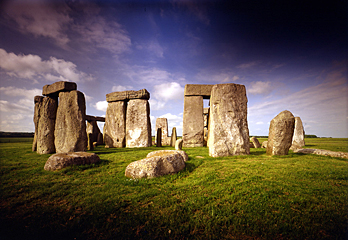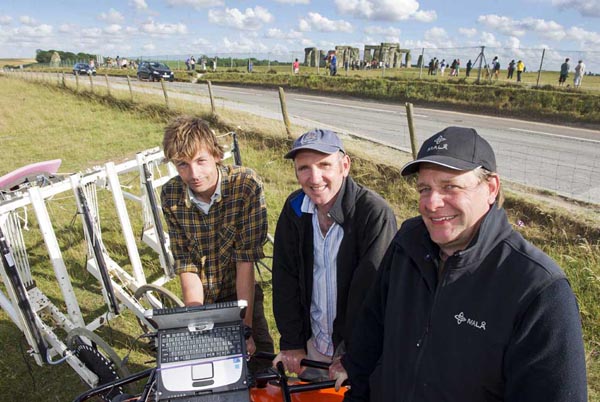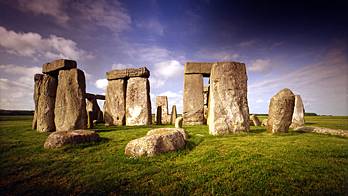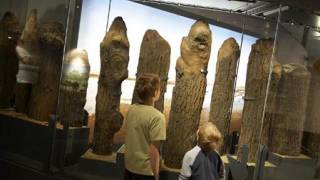Sister monument to Stonehenge may have been found
Source: metronews.ca

Scientists scouring the area around Stonehenge said Thursday they have uncovered a circular structure only a few hundred meters (yards) from the world famous monument.
There’s some debate about what exactly has been found. The survey team which uncovered the structure said it could be the foundation for a circle of freestanding pieces of timber, a wooden version of Stonehenge.
Wooden circle found new Stonehenge
Video from: YouTube.com
But Tim Darvill, a professor of archaeology at Bournemouth University in southern England, expressed skepticism, saying he believed it was more likely a barrow, or prehistoric tomb.
Darvill did say that the circle was one of an expanding number of discoveries being made around Stonehenge which "really shows how much there is still to learn and how extensive the site really was."

The team involved in the new find at Stonehenge from left, archeologist Eamonn Baldwin, University of Birmingham with archeological geophysicist Dr Chris Gaffney of University of Bradford with Professor Wolfgang Neubauer, director of the Ludwig Boltzmann Institute for Archaeological Prospection and Virtual Archaeology in Vienna; near Stonehenge, near the city of Salisbury, Britain. British archeologists working near Stonehenge have discovered a ’timber equivalent’ of the world-renowned prehistoric monument. The scientists found a circular ditch containing deep pits about 900 metres away from the giant stones. EPA/UNIVERSITY OF BIRMINGHAM
"In its day Stonehenge was at the centre of the largest ceremonial centre in Europe," he said.
The stonehenge that is visible today is thought to have been completed about 3,500 years ago, although the first earthwork henge on the site was probably built more than 5,000 yeas ago.
Although antiquarians have been poking around the area since the 18th century, excavations are now tightly restricted. So archeologists have been scanning the surrounding fields and pastures with magnetic and radar sensors pulled across the grass by tractors or quad bikes.
The new structure was found when scans identified a cluster of deep pits surrounded by a ring of smaller holes about 900 metres (a little over half a mile) from Stonehenge and within sight of its famous standing stones.
University of Birmingham archaeologist Henry Chapman said he was convinced the small holes were used to secure a circle of wooden poles which stood "possibly three or more meters (10 or more feet) high."
The timber henge — a name given to prehistoric monuments surrounded by a circular ditch — would have been constructed and modified at the same time as its more famous relative, and probably had some allied ceremonial or religious function, Chapman said in a telephone interview from Stonehenge.
Exactly what kind of ceremonies those were is unclear. The new henge joins a growing complex of tombs and mysterious Neolithic structures found across the area.
The closest equivalent is probably the nearby Woodhenge, a monument once composed of six rings of wooden posts enclosed by an earth embankment. Excavations there in the 1970s revealed the body of child whose skull had been split buried at the centre of the henge — hinting at the possibility of human sacrifice.
A stone’s throw from the newly found henge is a formation known as the Cursus, a 3-kilometre-long (1.8-mile-long) earthwork whose purpose remains unknown. Also nearby is a puzzling chunk of land known as the Northern Kite Enclosure; Bronze Age farmers seem to have avoided cultivating crops there, although no one is sure quite why.
The whole area around Stonehenge is dotted with prehistoric cemeteries — some of which predate the monument itself — and new discoveries are made occasionally.
Last year, researchers said they had found a small circle of stones on the banks of the nearby River Avon. Experts speculated the stone circle — dubbed "Bluehenge" because it was built with bluestones — may have served as the starting point of a processional walk that began at the river and ended at Stonehenge.
Chapman’s team is still in the early stages of its work, having surveyed only about four square kilometres (1.5 square miles) of the 16 square kilometres (six square miles) it eventually plans to map.
The survey is being led by the University of Birmingham and the Austria-based Ludwig Boltzmann Institute for Archaeological Prospection and Virtual Archaeology, with support from other institutions and researchers from Germany, Norway and Sweden.
Henges of various descriptions exist throughout Britain — from the Standing Stones o’ Stenness on the northern island of Orkney to the Maumbury Rings in southern England county of Dorset.
Stonehenge, a World Heritage Site, remains the best-known.
Article from: metronews.ca






















